The question of Protestantism’s relationship to the church catholic has been of scholarly interest since the sixteenth century.
Roman Catholic polemics regularly highlighted the newness of the Reformation, arguing that Protestant churches were not connected to the ancient and medieval church, but were wholly novel and sectarian offshoots. Consequently, the Protestants of the Reformation and post-Reformation periods often had to address such challenges as: Where your church was before Luther?
It was assumed by Roman Catholic theologians that they had the ancient pedigree of orthodoxy, and that the Protestants were heretics and schismatics and needed to be dealt with accordingly. One approach that Protestants took to answering the novelty challenge was to pillage church history looking for a line of succession that would oftentimes be taken through marginal groups like the Waldenses that Protestants would otherwise have had little to do with. The issues pertaining to ecclesial provenance played into the broader questions of the nature and unity of the church.

James Ussher and a Reformed Episcopal Church: Sermons and Treatises on Ecclesiology
Richard Snoddy, ed.
James Ussher and a Reformed Episcopal Church: Sermons and Treatises on Ecclesiology
Richard Snoddy, ed.
Protestants not only argued that their movement (as variegated as it was) was in line with the Great Tradition, they also saw themselves in substantial unity with true Christians everywhere and at any time. This, they argued, was contrary to the institutionalism of the papacy, that was in their view decidedly non-catholic. For Protestants, this was so because the papacy too rigidly required adherence to the formal structures of the church, not allowing those of other communions to be deemed as Christians. The Protestants saw that with the progress of time and corruption, the Roman Church had become so deformed that it needed to be reformed, to return to continuity with the earlier tradition.
James Ussher (1581-1656)
In this milieu James Ussher (1581-1656) distinguished himself as one of the foremost Protestant polemicists against Roman Catholicism in his native Ireland as well as in England, where he spent significant time in the 1640s. Ussher had grown up in a highly combative religious context as a Protestant theologian in a largely Catholic country. His teaching position at the recently formed Trinity College Dublin was that of Professor of Theological Controversies, indicating that his primary role was to engage the controversies of the day, namely that of Roman Catholicism.
A good number of Ussher’s writings address the Catholic problem, most notably his Answer to a Challenge Made By a Jesuit in Ireland (1625), that provides a detailed historical and theological critique of the Catholic theology of William Malone. In recognition of his abilities as a theological controversialist, both the Parliamentarians and the Royalists sought his support in the English Civil Wars. Yet Ussher was not simply a premier apologist for the Protestant cause, he was also a devoted churchman.
We see his commitment to the church in his decision to side with Charles Stuart against Parliament, due largely to his view of the divine right of kings. Ussher’s churchmanship is also seen in how he ran up the ranks of the Church of Ireland, taking ecclesiastical positions in Dublin, as well as the bishopric of Meath (1621), eventually becoming Archbishop of Armagh (1625), where he became primate over all of Ireland. In light of these two major aspects of his theological career, it is not surprising that a large number of his writings deal with ecclesiology, whether to situate the Church of Ireland in its ancient and catholic context or to explain the true nature of the church.
A number of his works on the nature of episcopacy were unique ecclesiological contributions. In his capacities as both polemicist and churchman Ussher engaged questions of unity and catholicity. As twenty-first century Protestantism has seen a renewed interest in “Reformed catholicity,” Ussher’s writings on these subjects are again highly relevant. Thus, it is with thanks that Richard Snoddy has edited this very useful collection of some of Ussher’s important works on the nature of the church, catholicity, and church government.
Richard Snoddy
Snoddy is a Fellow at both Queen’s University Belfast and London School of Theology and is editor of Evangelical Quarterly. His James Ussher and a Reformed Episcopal Church is part of the Library of Early English Protestantism, a series published with the Davenant Institute that introduces important but neglected Protestant writings to the church today.[1] The Davenant Institute recently published works in this series by John Jewel and George Carleton on political theology, and John Davenant on predestination.
The theme of the Ussher book, namely Protestant ecclesiology, sits well with the overall aims of the Davenant Institute, that resources evangelicalism with the wisdom from the Protestant past and the greater Christian tradition. Beyond how Snoddy’s book fits with that stated aim, it also offers a number of helpful contributions to studies of early modern Protestantism.
Particularly, it makes available for the first time Ussher’s 1620 sermon at the Temple Church, the chapel for the Inns of Court. Preaching from Revelation 19:20 before some of the most powerful lawyers in England, Ussher set the European military conflicts in apocalyptic terms showing from his historicist reading of Revelation that Catholicism would be finally defeated and judged. Snoddy is the ideal editor for this volume as his doctoral dissertation, now published with Oxford University Press, is an exemplary study of Ussher’s soteriology.
In the book under review, Snoddy provides a scholarly and accessible introduction to Ussher and his ecclesiology. He sets Ussher’s context as an early-modern Reformed theologian and provides an historical backdrop for the sources in each of the chapters. For instance, we learn that Ussher’s 1621 communion sermon before the Commons was preached in order to discover any crypto-Catholics who could not take the Eucharist (xv). Ussher’s “The Original of Bishops and Metropolitans” (1644) was a contribution to a pamphlet war over church government where he defended the office of bishop as being grounded in both Old and New Testaments as well as in church history (xxx-xxxi).
For the sake of this short review, we will focus on Ussher’s “A Brief Declaration of the Universality of the Church (1624)” that both addresses what true catholicity looks like and offers a critique of the purported universality of the Roman Catholic Church. This sermon is representative and provides a window into seventeenth-century Protestant views of catholicity and anti-Roman polemic.
“A Brief Declaration”
“A Brief Declaration” was preached before King James at Wanstead, near London, and was published separately and as an appendix to Answer to a Jesuit. Ussher’s text is Ephesians 4:13: “Till we all come in the unity of the faith, and of the knowledge of the Son of God, unto a perfect man, unto the measure of the stature of the fulness of Christ” (KJV). He begins by arguing that the ark of the covenant was a type of Christ, where true propitiation for sin was made (62-63).
Just as the ark moved from place to place, so too did Christ. When he returned to his Father at the ascension, Christ bestowed gifts to his church, namely Word and Sacrament that were to be dispensed with as part of the regular ministerial duties of church officers. As a body, the church is “conjoined” to Christ and receives its fullness from him (66), thus being the recipients of these gifts. This union with Christ is the sole ground for the unity of the church that Paul enjoins the Ephesians to maintain.
Using scholastic categories, Ussher’s hearers learn of the “matter” of the metaphorical building of the church in Ephesians 4 is its “structure” and “foundation.” This matter pertains to its people, true Christians who together form the universal or catholic church. He defines the truly catholic church as “of one entire body made up by a collection and aggregation of all the faithful unto the unity thereof” (67). As parts that are conjoined to the whole, the church is practically held together by her bishops.
This catholicity is worldwide and is located spiritually and not in terms of an institution, as in Roman Catholicism. According to Ussher, Roman Catholics are schismatics worse than the Donatists (whose schism was, in comparison, “petty rents” [68]) because of the all-encompassing nature of their separatism. For Rome, only those who have the pope as their head bishop are of the true company of the church, all those who are not remain outside.
Ussher argued that the Roman Church is the woman who rides the beast in Revelation 17, who is the “mother of all schism.” The papacy has excluded other Christian communions across the globe, including not only European Protestants, but also the Russian, Greek, Egyptian, Eastern Orthodox and other such churches. For all their cry of being “Catholic,” the papacy is remarkably sectarian.
Yet if true unity is maintained around what Ussher describes as the “fundamental principles of the catholic faith” as defined by the creeds, there can be a unified church that spans a geographical diversity (74) without requiring institutional conformity.
Ussher’s own catholicity is on display when he admits that any who hold by faith to these “common principles” are truly Christian (75). When answering whether a Roman Catholic can be saved, Ussher went so far as to allow them to be a part of the church catholic, insofar as they are not actually committed to the errors of the papacy. A Catholic who is ignorant of the claims made by a pope like Boniface VIII, who argued for the universal jurisdiction of the Pontiff, can truly be said to be saved. It is only those who are specifically “papist” who exclude themselves because of their schism.
The Roman Church may have a “carnal unity,” but not a true unity as the body of Christ (72). If one enters the church through the door of baptism (75) and maintains true catholic faith, they can be said to be part of the universal church. Though the Papacy can be deemed a true church, there are only vestiges of the faith remaining, as seen in their use of the creed and liturgical calendar (82). Errors like transubstantiation endanger her foundations. Yet there were those who were “preserved” within by God’s mercy, excluding them from the dangers of the “popery” that reigned (83).
While much more can be said of Ussher’s sermon on catholicity, it is noteworthy to see the way he worked through the nature of true belief in light of heresy and schism. In order to prove that there can be true Christians within the papacy, he turned to church history for examples. Here he argued that there were those who, in ignorance, had fellowship with the Arians in the ancient church, but who were nevertheless true Christians (86) because they were ignorant of their heresy. Nevertheless, true knowledge of Christ is the ideal, and where this true knowledge is published, ignorance becomes no excuse.
Only those who do not have the capacity for reason, like infants and the mentally infirmed, are excused by their lack of knowledge (90). True knowledge, for Ussher, is not merely intellectual, but is also a matter of the heart—what he calls “practical” or “experimental” knowledge (90-92). This is “a knowledge grounded upon deep experience of the virtue of Christ’s death and resurrection” in the soul (91). This practical knowledge expresses itself in “head, heart, hand” (92). Where this knowledge is willfully ignored, as in the papacy, there can be no excuse.
We see not only from this sermon, but from the book as a whole, that catholicity is something to be pursued by all Christians. The church is primarily catholic over local. That is, the whole takes priority over the parts, though the two cannot be without each other. Protestants today, who can tend to sectarianism, would do well to remember this. True unity can be held with other communions who hold to the fundamental principles of the faith, but it is those fundamentals that define unity. These can even be found, though not often, in Roman Catholicism.
Not only as ministers, but as laity as well, we should all labor for the unity of the faith and the bond of peace. In providing fresh access to these sources of Ussher’s, with their focus on the importance of doctrine and unity, Richard Snoddy has done the church a great service, as ours is a day of growing division. We need the irenic spirit of an Ussher to push us through division into a true universal unity grounded in the core of the Christian faith.
[1] Full disclosure: this reviewer has sat on the board of directors for the Davenant Institute.






















